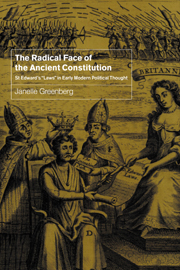Book contents
- Frontmatter
- Contents
- Acknowledgments
- 1 Hagiography and historiography: the long shadow of Edward the Confessor
- 2 “Those most noble and equitable laws of St. Edward”: from the cult of the Confessor to the cult of the Confessor's laws
- 3 “Divers and sundry ancient histories and chronicles”: the articulation of the ancient constitution in the Tudor period
- 4 “By lex terrae is meant the laws of St. Edward the Confessor”: the footprints of the Saxons in the early seventeenth century
- 5 “You shall be king while you rule well”: the radical ancient constitution in the civil wars and interregnum
- 6 “That noble transcript of the original contract, the Confessor's laws”: the radical ancient constitution in the late Stuart period
- Bibliography
- Index
6 - “That noble transcript of the original contract, the Confessor's laws”: the radical ancient constitution in the late Stuart period
Published online by Cambridge University Press: 29 August 2009
- Frontmatter
- Contents
- Acknowledgments
- 1 Hagiography and historiography: the long shadow of Edward the Confessor
- 2 “Those most noble and equitable laws of St. Edward”: from the cult of the Confessor to the cult of the Confessor's laws
- 3 “Divers and sundry ancient histories and chronicles”: the articulation of the ancient constitution in the Tudor period
- 4 “By lex terrae is meant the laws of St. Edward the Confessor”: the footprints of the Saxons in the early seventeenth century
- 5 “You shall be king while you rule well”: the radical ancient constitution in the civil wars and interregnum
- 6 “That noble transcript of the original contract, the Confessor's laws”: the radical ancient constitution in the late Stuart period
- Bibliography
- Index
Summary
Every time a society finds itself in crisis, it instinctively turns its eyes towards its origins and looks there for a sign.
Octavio PazINTRODUCTION
When Charles II entered London in May of 1660, he might reasonably have anticipated governing a people who lauded the kingship and exalted the royal authority. Indeed, royalist fervor ran so high that the political nation imposed hardly any official conditions upon his return. Moreover, the Convention, which met from March to December of 1660, rolled back the clock by restoring the monarchy, the church, and the House of Lords. Still, Charles II could by no means claim an unalloyed victory. In the first place, most early reforms of the Long Parliament stood, denying him extra-parliamentary levies and recourse to the old prerogative courts. In addition, the Triennial Act of 1641 remained in force for the time being. But most telling of all, from the very beginning of the Restoration signs pointed unmistakably to the tenacity of radical ancient constitutionalism. The extent to which its language and ideas had taken root appears from a resolution passed by the Convention Parliament on May 1,1660, the eve of the king's return. Here the two houses resolved that “according to the ancient and fundamental laws of the kingdom, the government is, and ought to be, by King, Lords, and Commons.”
- Type
- Chapter
- Information
- The Radical Face of the Ancient ConstitutionSt Edward's 'Laws' in Early Modern Political Thought, pp. 243 - 296Publisher: Cambridge University PressPrint publication year: 2001



